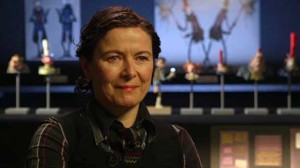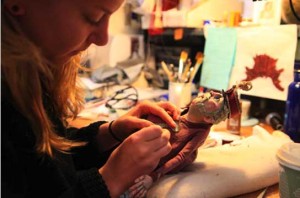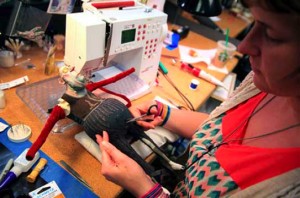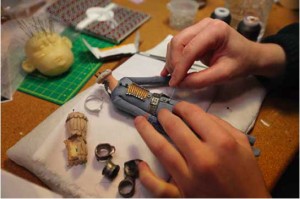
Based on Here Be Monsters, the bestselling fantasy book by Alan Snow, Laika’s Annie Award-nominated film, The Boxtrolls, is a coming-of-age adventure story told through hybrid stop-motion, hand-drawn and CG animation. As in a live-action feature, a stop-motion feature has physical sets and performers and, though these performers may only be nine-inch tall puppets, they need to be clothed.
Costume designer Deborah Cook, who has been with the animation studio for nine years, was tasked with creating the wardrobe for the diminutive cast. “Initially I just came for three months to work on Coraline, but it kept rolling and rolling into this wonderful thing that I just couldn’t drag myself away from,” shared Cook. “I was enjoying myself too much, so I stayed.”
Cook’s ‘wiggly route’ into costume design originated with her sculpture and fine arts studies at Saint Martin’s School of Art in London. In her work, she used fabrics and upholstery over an armature framework, a construction much like the puppetry in stop-motion animation. Because she worked in fabrics and was detail-oriented, she began receiving requests to design costumes for film and video, as well as getting work making small puppets and their costumes. Eventually she got more and more work with small scale and miniatures.
 The size and scale of each puppet is determined by the smallest one. Because of the small scale, elements of each costume need to be fabricated. “It’s all handmade,” explained Cook. “Our films are quite hybrid now. We’re getting more into working with new technologies with the VFX crew, but they mimic our built costumes so there is a more holistic world between our VFX textures and our real-world textures.”
The size and scale of each puppet is determined by the smallest one. Because of the small scale, elements of each costume need to be fabricated. “It’s all handmade,” explained Cook. “Our films are quite hybrid now. We’re getting more into working with new technologies with the VFX crew, but they mimic our built costumes so there is a more holistic world between our VFX textures and our real-world textures.”
Certain types of fabric work better in the world of stop-motion. Too much texture can appear out of proportion when scale is reduced. “All the costumes are hand-tailored,” said Cook. “We dye all the fabrics ourselves and are particular to select fabrics that work with our scale. The fabrics have different qualities to them, like a little stretch so there’s a return quality to them. If they bag out at a characters knee, it goes back to its original form when their knees unbend.”
 Many of the costumes in The Boxtrolls contain bits of lace, fur or elaborate buttons, but those real items don’t read well on a small scale, so they needed to be fabricated. “All the buttons were laser-cut out of a fine-laminate wood so the tops were engraved with the little holes to sew them on. They’re all hand-sewn on,” revealed Cook. What works in the studio might not work on-camera, so all wardrobe needed to be screen-tested before the costume was approved for production.
Many of the costumes in The Boxtrolls contain bits of lace, fur or elaborate buttons, but those real items don’t read well on a small scale, so they needed to be fabricated. “All the buttons were laser-cut out of a fine-laminate wood so the tops were engraved with the little holes to sew them on. They’re all hand-sewn on,” revealed Cook. What works in the studio might not work on-camera, so all wardrobe needed to be screen-tested before the costume was approved for production.
Because of all the handling that goes into stop-motion, multiples are made of each puppet wearing its costume, which means that multiples of the characters’ outfits are produced. With over 40 stages shooting simultaneously for eight to 10 hours a day, and thousands of handlings over a couple years’ of filming, at least half a dozen identical, and durable, duplicates of each costume – and more for major characters – were made.
 One of the biggest challenges Cook faced was a dance scene with its multitude of characters and action. She focused on the main characters that take up most of the frame. Some background dancers are actually CG versions of real characters. Cook collaborated with the directors and project designers on how the characters would be defined by their costumes, which were illustrated by the character designer. From that basic design, she developed the color palette, costume shapes and details through research, often using fine art of the period to inform her decisions. “I do research into the age, the era, the creative license that we want to invest these characters with,” Cook noted. “We take it into a fantasy realm of our own to develop our film style.”
One of the biggest challenges Cook faced was a dance scene with its multitude of characters and action. She focused on the main characters that take up most of the frame. Some background dancers are actually CG versions of real characters. Cook collaborated with the directors and project designers on how the characters would be defined by their costumes, which were illustrated by the character designer. From that basic design, she developed the color palette, costume shapes and details through research, often using fine art of the period to inform her decisions. “I do research into the age, the era, the creative license that we want to invest these characters with,” Cook noted. “We take it into a fantasy realm of our own to develop our film style.”
She supervised a team of fabricators as they constructed the outfits. The paint department aged the clothing and made sure all duplicates looked the same, both in the consistency of wear-and-tear as well as color. “Even the paint department in this particular film brought its own strategy to the color and the line work,” remarked Cook. “Some of the costumes had impressionistic, painterly color lines just on the edge to accent the colors and accent the cuffs. We brought those impressionistic colors into the costumes through paint.”
There were up to 15 artisans of various specialties who contributed to the creation of the costumes in what was both a collaborative and a learning process as the team discovered new techniques and different technology came available. Nevertheless, whatever method was used, Cook made sure the characters were the best dressed.





